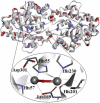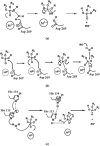Computational enzymology for degradation of chemical warfare agents: promising technologies for remediation processes
- PMID: 31294152
- PMCID: PMC6604975
- DOI: 10.3934/microbiol.2017.1.108
Computational enzymology for degradation of chemical warfare agents: promising technologies for remediation processes
Abstract
Chemical weapons are a major worldwide problem, since they are inexpensive, easy to produce on a large scale and difficult to detect and control. Among the chemical warfare agents, we can highlight the organophosphorus compounds (OP), which contain the phosphorus element and that have a large number of applications. They affect the central nervous system and can lead to death, so there are a lot of works in order to design new effective antidotes for the intoxication caused by them. The standard treatment includes the use of an anticholinergic combined to a central nervous system depressor and an oxime. Oximes are compounds that reactivate Acetylcholinesterase (AChE), a regulatory enzyme responsible for the transmission of nerve impulses, which is one of the molecular targets most vulnerable to neurotoxic agents. Increasingly, enzymatic treatment becomes a promising alternative; therefore, other enzymes have been studied for the OP degradation function, such as phosphotriesterase (PTE) from bacteria, human serum paraoxonase 1 (HssPON1) and diisopropyl fluorophosphatase (DFPase) that showed significant performances in OP detoxification. The understanding of mechanisms by which enzymes act is of extreme importance for the projection of antidotes for warfare agents, and computational chemistry comes to aid and reduce the time and costs of the process. Molecular Docking, Molecular Dynamics and QM/MM (quantum-mechanics/molecular-mechanics) are techniques used to investigate the molecular interactions between ligands and proteins.
Keywords: computational methods; enzymatic biodegradation; oximes; warfare nerve agents.
Conflict of interest statement
Conflict of Interest: The authors confirm that this article content has no conflict of interest.
Figures










Similar articles
-
Theoretical Studies Applied to the Evaluation of the DFPase Bioremediation Potential against Chemical Warfare Agents Intoxication.Int J Mol Sci. 2018 Apr 23;19(4):1257. doi: 10.3390/ijms19041257. Int J Mol Sci. 2018. PMID: 29690585 Free PMC article.
-
Computational Enzymology and Organophosphorus Degrading Enzymes: Promising Approaches Toward Remediation Technologies of Warfare Agents and Pesticides.Curr Med Chem. 2016;23(10):1041-61. doi: 10.2174/0929867323666160222113504. Curr Med Chem. 2016. PMID: 26898655 Review.
-
Review about Structure and Evaluation of Reactivators of Acetylcholinesterase Inhibited with Neurotoxic Organophosphorus Compounds.Curr Med Chem. 2021;28(7):1422-1442. doi: 10.2174/0929867327666200425213215. Curr Med Chem. 2021. PMID: 32334495 Review.
-
Molecular modeling and in vitro reactivation study between the oxime BI-6 and acetylcholinesterase inhibited by different nerve agents.J Biomol Struct Dyn. 2015 Sep;33(9):2048-58. doi: 10.1080/07391102.2014.989408. Epub 2014 Dec 18. J Biomol Struct Dyn. 2015. PMID: 25407587
-
In silico pharmacophore model for tabun-inhibited acetylcholinesterase reactivators: a study of their stereoelectronic properties.Chem Res Toxicol. 2010 Jan;23(1):26-36. doi: 10.1021/tx900192u. Chem Res Toxicol. 2010. PMID: 20028185
Cited by
-
Biodegradation of Organophosphorus Compounds Predicted by Enzymatic Process Using Molecular Modelling and Observed in Soil Samples Through Analytical Techniques and Microbiological Analysis: A Comparison.Molecules. 2019 Dec 23;25(1):58. doi: 10.3390/molecules25010058. Molecules. 2019. PMID: 31878010 Free PMC article.
-
Trends in the Recent Patent Literature on Cholinesterase Reactivators (2016-2019).Biomolecules. 2020 Mar 12;10(3):436. doi: 10.3390/biom10030436. Biomolecules. 2020. PMID: 32178264 Free PMC article. Review.
-
Theoretical Studies Applied to the Evaluation of the DFPase Bioremediation Potential against Chemical Warfare Agents Intoxication.Int J Mol Sci. 2018 Apr 23;19(4):1257. doi: 10.3390/ijms19041257. Int J Mol Sci. 2018. PMID: 29690585 Free PMC article.
-
Chloropicrin induced ocular injury: Biomarkers, potential mechanisms, and treatments.Toxicol Lett. 2024 May 15;396:70-80. doi: 10.1016/j.toxlet.2024.04.006. Epub 2024 Apr 25. Toxicol Lett. 2024. PMID: 38677567 Free PMC article. Review.
-
Carrier Variety Used in Immobilization of His6-OPH Extends Its Application Areas.Polymers (Basel). 2023 Jan 24;15(3):591. doi: 10.3390/polym15030591. Polymers (Basel). 2023. PMID: 36771892 Free PMC article. Review.
References
-
- Castro AA, Caetano MS, Silva TC, et al. Molecular docking, metal substitution and hydrolysis reaction of chiral substrates of phosphotriesterase. Comb Chem High Throughput Screen. 2016;19:334–344. - PubMed
-
- Calvert GM, Karnik J, Mehler L, et al. Acute pesticide poisoning among agricultural workers in the United States, 1998–2005. Am J Ind Med. 2008;51:883–898. - PubMed
-
- Berny P. Pesticides and the intoxication of wild animals. J Vet Pharmacol Ther. 2007;30:93–100. - PubMed
-
- Lima WEA, Pereira AF, Castro AA, et al. Flexibility in the molecular design of Acetylcholinesterase Reactivators: Probing Representative Conformations by Chemometric Techniques and Docking/QM Calculations. Lett Drug Des Discov. 2016;13:360–371.
-
- Sartorelli J, Castro AA, Ramalho TC, et al. Asymmetric biocatalysis of the nerve agent VX by human serum paraoxonase 1: molecular docking and reaction mechanism calculations. Med Chem Res. 2016;25:2521–2533.
LinkOut - more resources
Full Text Sources
Miscellaneous
